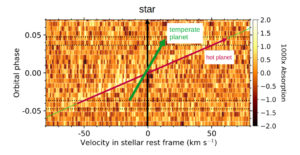New papers: Science with the ANDES spectrograph for the ELT
My group is contributing the the second-light instrument suite for the Extremely Large Telescope: we are developing and building the optical-ultraviolet (UBV) part of the high-resolution spectrograph ANDES. And of course, we are also highly interested in the scientific avenues that will open up with this instrument. The two recent White Papers on exoplanetary and stellar science with ANDES lay out many of the exciting ideas that we can explore:

Ground-breaking Exoplanet Science with the ANDES spectrograph at the ELT
Palle, Enric; Biazzo, Katia; Bolmont, Emeline; Molliere, Paul; Poppenhaeger, Katja; Birkby, Jayne; Brogi, Matteo et al.; eprint arXiv:2311.17075; Submitted to Experimental Astronomy.
In the past decade the study of exoplanet atmospheres at high-spectral resolution, via transmission/emission spectroscopy and cross-correlation techniques for atomic/molecular mapping, has become a powerful and consolidated methodology. The current limitation is the signal-to-noise ratio during a planetary transit. This limitation will be overcome by ANDES, an optical and near-infrared high-resolution spectrograph for the ELT. ANDES will be a powerful transformational instrument for exoplanet science. It will enable the study of giant planet atmospheres, allowing not only an exquisite determination of atmospheric composition, but also the study of isotopic compositions, dynamics and weather patterns, mapping the planetary atmospheres and probing atmospheric formation and evolution models. The unprecedented angular resolution of ANDES, will also allow us to explore the initial conditions in which planets form in proto-planetary disks. The main science case of ANDES, however, is the study of small, rocky exoplanet atmospheres, including the potential for biomarker detections, and the ability to reach this science case is driving its instrumental design. Here we discuss our simulations and the observing strategies to achieve this specific science goal. Since ANDES will be operational at the same time as NASA’s JWST and ESA’s ARIEL missions, it will provide enormous synergies in the characterization of planetary atmospheres at high and low spectral resolution. Moreover, ANDES will be able to probe for the first time the atmospheres of several giant and small planets in reflected light. In particular, we show how ANDES will be able to unlock the reflected light atmospheric signal of a golden sample of nearby non-transiting habitable zone earth-sized planets within a few tenths of nights, a scientific objective that no other currently approved astronomical facility will be able to reach.
The discovery space of ELT-ANDES. Stars and stellar populations
Roederer, Ian U.; Alvarado-Gómez, Julián D.; Allende Prieto et al. (including Poppenhaeger, K.); eprint arXiv:2311.16320; Submitted to Experimental Astronomy.
The ArmazoNes high Dispersion Echelle Spectrograph (ANDES) is the optical and near-infrared high-resolution echelle spectrograph envisioned for the European Extremely Large Telescope (ELT). We present a selection of science cases, supported by new calculations and simulations, where ANDES could enable major advances in the fields of stars and stellar populations. We focus on three key areas, including the physics of stellar atmospheres, structure, and evolution; stars of the Milky Way, Local Group, and beyond; and the star-planet connection. The key features of ANDES are its wide wavelength coverage at high spectral resolution and its access to the large collecting area of the ELT. These features position ANDES to address the most compelling and potentially transformative science questions in stellar astrophysics of the decades ahead, including questions which cannot be anticipated today.